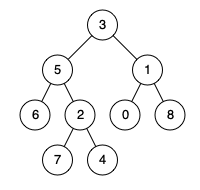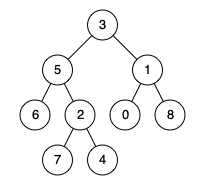Difficulty: Medium
Related Topics: Tree
Given a binary tree, find the lowest common ancestor (LCA) of two given nodes in the tree.
According to the : “The lowest common ancestor is defined between two nodes p and q as the lowest node in T that has both p and q as descendants (where we allow a node to be a descendant of itself).”
Example 1:

Input: root = [3,5,1,6,2,0,8,null,null,7,4], p = 5, q = 1Output: 3Explanation: The LCA of nodes 5 and 1 is 3.
Example 2:

Input: root = [3,5,1,6,2,0,8,null,null,7,4], p = 5, q = 4
Output: 5
Explanation: The LCA of nodes 5 and 4 is 5, since a node can be a descendant of itself according to the LCA definition.
Example 3:
Input: root = [1,2], p = 1, q = 2
Output: 1
Constraints:
- The number of nodes in the tree is in the range
[2, 10]. -10 <= Node.val <= 10- All
Node.valare unique. p != qpandqwill exist in the tree.
Solution
Language: Java
class Solution {
public TreeNode lowestCommonAncestor(TreeNode root, TreeNode p, TreeNode q) {
// 出口
// 1. 没有 LACA
if (root == null) {
return null;
}
// 2. 节点自己也可以是自己的祖先
//
// LCA -> q p <- LCA
// / \
// p q
//
if (root == p || root == q) {
return root;
}
// 1. 往左子树搜索
// 2. 往右子树搜索
TreeNode left = lowestCommonAncestor(root.left, p, q);
TreeNode right = lowestCommonAncestor(root.right, p, q);
// left == null 表示没有在左子树中找到 p 或 q
// 因为题目说了 p 和 q 是在 Tree 上的点
// 如果没有在左子树找到 p 或 q,那么右子树中必然有 p 或 q
// 所以把我们在右子树中找到的结果返回去,充当局部解
if (left == null) {
return right;
}
if (right == null) {
return left;
}
// 如果我们能在左子树中找到 p 或 q 且在右子树中找到 p 或 q
// 那么 root 就是 LCA
return root;
}
}

